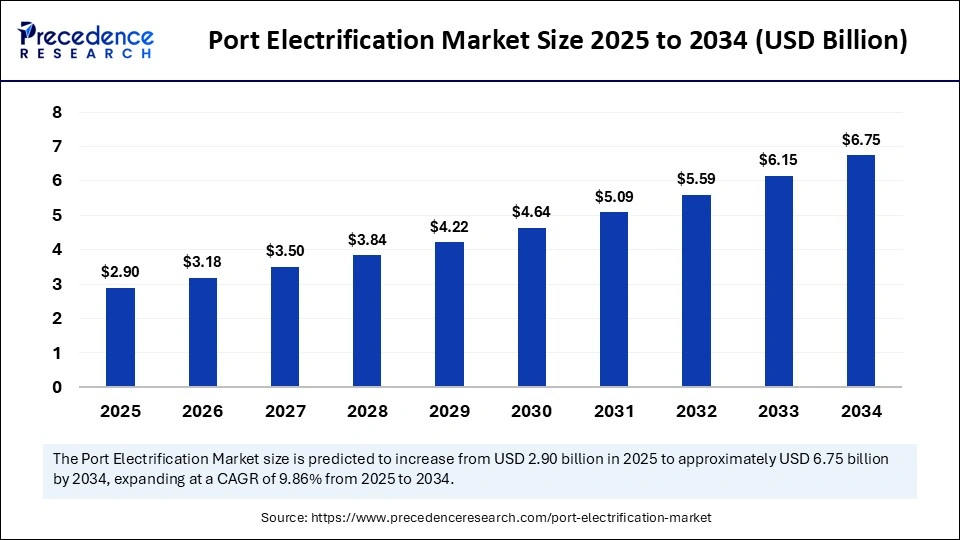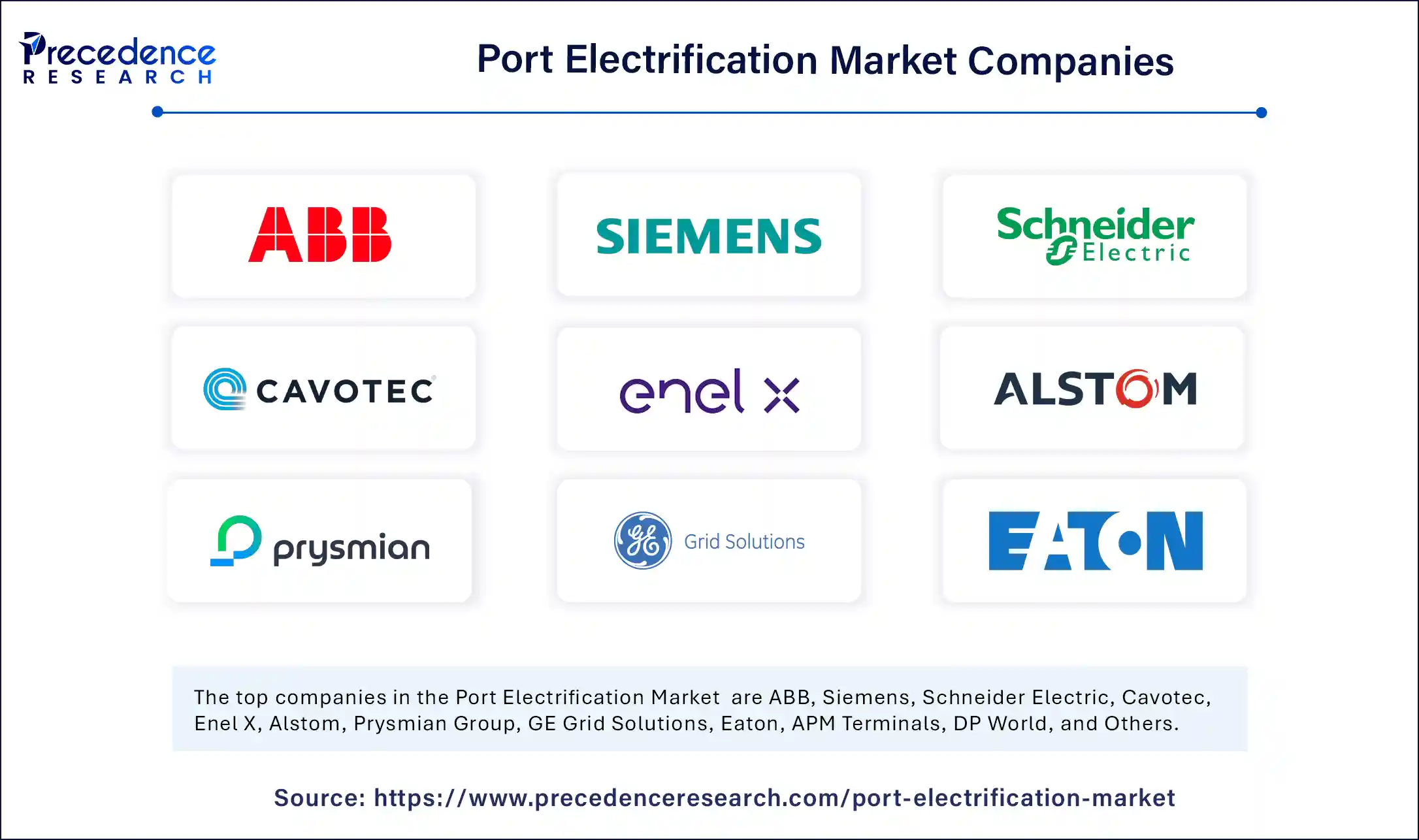Port Electrification Market: Powering Sustainable Maritime Infrastructure
As global trade intensifies and environmental regulations become more stringent, ports are transforming into smarter, cleaner, and more energy-efficient hubs. One of the most significant shifts in this transformation is port electrification—the process of replacing fossil fuel-powered port equipment and vessels with electric alternatives, and integrating renewable energy and energy management systems into port operations. The move toward port electrification is central to achieving carbon neutrality goals and enhancing the operational efficiency of maritime logistics.
This blog explores the dynamics of the port electrification market, including key drivers, technological advancements, challenges, regional developments, the role of artificial intelligence, and future trends shaping the maritime and port infrastructure landscape.
Market Overview and Growth Forecast
The global port electrification market size is calculated at USD 2.90 billion in 2025 and is forecasted to hit around USD 6.75 billion by 2034, accelerating at a CAGR of 9.86% from 2025 to 2034.

This growth reflects a fundamental shift in how ports are powered and operated. Port authorities worldwide are investing in electrification infrastructure to comply with stricter emission standards, reduce fuel consumption, and improve air quality around port zones, which are often located near densely populated urban areas. Electrification also supports the integration of renewable energy sources, such as solar and wind, into port ecosystems.
Key Market Drivers
One of the primary drivers of the port electrification market is the global push toward decarbonization and sustainability in maritime operations. Ports are significant contributors to greenhouse gas emissions, especially through diesel-powered cargo handling equipment, cranes, and auxiliary ship engines. Governments and regulatory bodies are enforcing emission reduction mandates through policies such as the International Maritime Organization’s MARPOL Annex VI and the EU’s Fit for 55 package.
The increasing demand for shore power systems, also known as cold ironing, is another major factor driving market growth. Shore power allows vessels to plug into the local electricity grid while docked, reducing the need to run auxiliary diesel engines and thereby cutting emissions and noise pollution. This is especially crucial for cruise terminals and container ports with high docking times.
Furthermore, the rise of automation in port operations is fueling the need for a stable and scalable electricity supply. Electrified infrastructure is essential to support electric automated guided vehicles (AGVs), cranes, and other smart systems, ensuring round-the-clock efficiency in loading and unloading cargo.
Technological Advancements
Technological innovations are playing a crucial role in the expansion of port electrification. Advancements in high-voltage shore connection systems and battery energy storage are making it feasible for ports to supply electricity to large vessels and equipment while maintaining power stability and safety. Modern shore power systems can now deliver power at both low and high voltages, catering to a wide range of vessels from ferries to cargo ships.
Battery-electric and hybrid-electric propulsion systems are also gaining traction in tugboats, harbor craft, and short-sea shipping vessels, all of which contribute to lower port emissions. The development of megawatt-scale charging stations for electric ships is emerging as a key technology for fully electrified port operations.
Smart grid integration is another area of innovation. Electrified ports are leveraging digital platforms and energy management systems to monitor and optimize power distribution, load balancing, and energy storage. This integration enables ports to coordinate renewable energy input with demand from ships and port equipment, enhancing both efficiency and sustainability.
What is the Role of AI in the Port Electrification Market?
Artificial intelligence is playing an increasingly pivotal role in accelerating the adoption and efficiency of port electrification. As ports transition toward smarter infrastructure, AI is being used to analyze vast datasets from electric equipment, energy usage, ship schedules, and weather conditions to optimize energy distribution, equipment operation, and power grid integration. With multiple electrified systems working simultaneously—such as shore power connections, electric cranes, and autonomous vehicles—AI enables real-time monitoring and predictive control to prevent overloading and ensure uninterrupted operations.
AI also enhances energy management by forecasting demand patterns and coordinating the usage of on-site renewable sources like solar and wind. Intelligent algorithms can decide when to draw power from the grid, when to store excess energy in batteries, and when to allocate it to electrified systems. This reduces waste, minimizes costs, and helps ports meet sustainability targets. Moreover, AI-powered digital twins are increasingly being deployed to simulate port operations and electrification scenarios, allowing stakeholders to test and implement optimized electrification strategies before committing capital. As AI continues to evolve, it will become a critical enabler for fully autonomous, low-emission port ecosystems.
Market Scope
| Report Coverage | Details |
| Market Size by 2034 | USD 6.75 Billion |
| Market Size in 2025 | USD 2.90 Billion |
| Market Size in 2024 | USD 2.64 Billion |
| Market Growth Rate from 2025 to 2034 | CAGR of 9.86% |
| Dominating Region | Europe |
| Fastest Growing Region | North America |
| Base Year | 2024 |
| Forecast Period | 2025 to 2034 |
| Segments Covered | Connection, Installation Type, Component, Port Equipment Type, and Region |
| Regions Covered | North America, Europe, Asia-Pacific, Latin America, and Middle East & Africa |
Market Challenges
Despite its promising outlook, the port electrification market faces several notable challenges. High upfront capital investment remains a primary barrier, especially for developing regions. Retrofitting existing port infrastructure for electrification, installing shore power facilities, and upgrading grid connections require substantial funding and long-term planning.
Interoperability and standardization also present challenges. Different ports and vessels often have varying technical requirements for voltage, frequency, and plug types, making it difficult to implement a uniform electrification solution across the global maritime sector. Efforts are underway by organizations such as the International Electrotechnical Commission (IEC) to establish global standards, but widespread adoption is still a work in progress.
In some cases, the availability of reliable, high-capacity electricity supply near ports can be limited. Ports located in areas with weak grid infrastructure may struggle to implement large-scale electrification projects unless major utility upgrades are completed. Additionally, integrating renewable energy sources into the port grid presents its own complexities in terms of intermittency and storage requirements.
Regional Market Insights
North America is witnessing strong momentum in the port electrification space, led by initiatives from the United States and Canada. U.S. ports such as the Port of Los Angeles and Port of Long Beach are at the forefront, investing heavily in shore power systems and electric drayage trucks under zero-emission freight strategies. Government funding and incentives, including the Inflation Reduction Act, are further accelerating electrification adoption.
Europe is also a major player, with countries like Norway, Germany, and the Netherlands actively implementing shore power and electric vessel technologies. The European Union’s Green Deal and maritime climate initiatives are driving ambitious targets for zero-emission ports by 2030. Scandinavian ports, in particular, are pioneers in clean port infrastructure, using hydropower and wind energy to power vessels and port operations.
The Asia-Pacific region is expected to witness the fastest growth in the coming years, driven by large-scale port expansions and smart city initiatives in countries like China, Japan, South Korea, and India. China’s Belt and Road Initiative and coastal sustainability policies are pushing for greener ports, with several ports already deploying shore power and electric cargo handling equipment.
In Latin America and Africa, the electrification trend is emerging more slowly due to budgetary constraints and infrastructural limitations. However, with increasing awareness of environmental and public health impacts, international funding and public-private partnerships are expected to support gradual adoption.
Competitive Landscape
The port electrification market includes a mix of global engineering firms, specialized equipment manufacturers, energy utilities, and maritime technology providers. Leading companies are focusing on integrated energy and infrastructure solutions, often partnering with port authorities and shipping companies to deliver turnkey electrification systems.
Prominent players in the market include:

- ABB
- Siemens
- Schneider Electric
- Cavotec
- Enel X
- Alstom
- Prysmian Group
- GE Grid Solutions
- Eaton
- APM Terminals
- DP World
- Adani Group
These firms are engaged in developing modular shore power units, grid connectivity infrastructure, smart charging platforms, and hybrid vessel power solutions. The competitive landscape is driven by innovation, customization, and the ability to align with evolving environmental regulations.
Future Outlook and Trends
Looking ahead, port electrification is set to become a cornerstone of sustainable maritime logistics. One of the most promising trends is the integration of renewable energy microgrids at port terminals. These systems combine solar panels, wind turbines, and battery storage with intelligent software to create self-sufficient, emission-free energy hubs.
Another emerging trend is the electrification of last-mile port transportation, including electric trucks, forklifts, and rail infrastructure. As e-commerce and intermodal transport grow, reducing emissions from port-related ground transport is becoming a priority.
In the long term, the rise of autonomous electric vessels and fully digitized smart ports will drive demand for high-capacity, fast-response electrification systems. Ports will evolve into energy-smart logistics hubs that not only power ships but also act as regional power centers supporting industrial zones and green corridors.
Conclusion
The port electrification market represents a critical step toward a cleaner, more efficient, and future-ready maritime industry. Driven by environmental regulations, technological innovation, AI integration, and growing public demand for sustainable infrastructure, ports are moving away from fossil fuels and embracing electrified systems. While challenges such as high investment costs and standardization hurdles persist, the long-term benefits of port electrification—including reduced emissions, better air quality, and enhanced operational efficiency—make it a transformative trend in global logistics. As more ports adopt smart electrification strategies, the maritime industry is set to play a leading role in global sustainability efforts.
Also Read: Next Generation Non-Volatile Memory Market
Get this report to explore global market size, share, CAGR, and trends, featuring detailed segmental analysis and an insightful competitive landscape overview @ https://www.precedenceresearch.com/sample/6211
You can place an order or ask any questions, please feel free to contact at sales@precedenceresearch.com|+1 804 441 9344